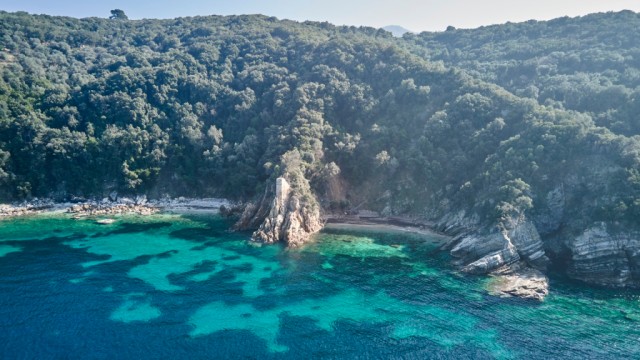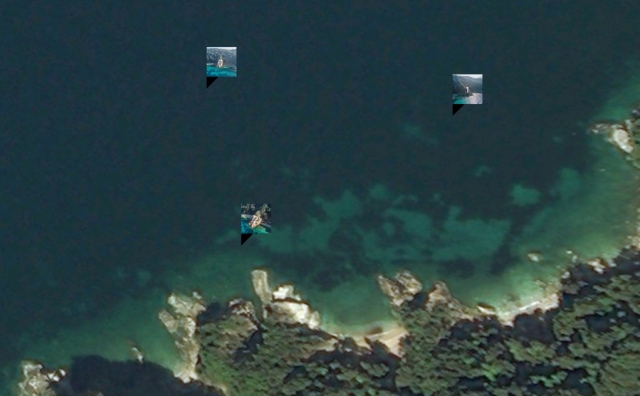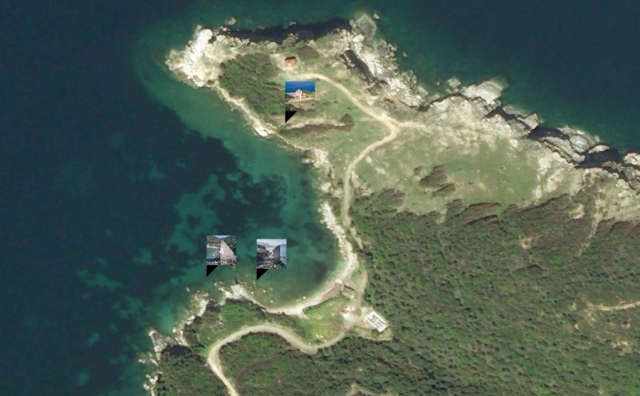I really thought I had seen quite a lot of Athos and its settlements and buildings (except from the farmhouses-kellia). So I was really surprized that the drone-images from an anonymous photographer had something new in store, as can see on the images at the end of this post. But here are first some images from arsanas Chilandariou and the Milutin tower:




The next pictures from the drone are taken at the spot below on the map near Esfigmenou, along the Athos costline. This place is seldomly visited by pilgrims, because there is a dead end road to the chapel Ag. Theódori. But there are interesting objects to be found along the coast near Esfigmenou, as the pictures below will soon show us.



On this part of the coast Theodosios discovered two interesting objects, situated here:












The question is why these two walls were build along the Athos coast: the first one cannot be reached by land and they both are near to eachother and on a very remote place. What could be their purpose? Clearly they are not in use anymore because they are crumbling down, but on the other hand they are not not totally ruined, at the harsh conditions where they are situated, next to the sea and at the shore, with its crashing waves. I could not find a plausible answer to these questions.
The man who took the pictures came with the idea that these walls have been build by fishermen, who used the walls to dry their nets. This could be, but why are they so high? And why on such desolate places? And why are these two walls exactly at this spot and why are there no other examples along the (Athos) coast (as far as I know)?
Does anyone have a plausible explanation?
Wim Voogd, 25/8
Thanks to all the wise and helpfull reactions of our readers, with an extensive investication about the subject by Japetus (worthwhile to read!), and also thanks to Vasílis/Efraim, “Byz history Tweep” and Keliotis), who also gave an answer to my question.
Japetus wrote in his first comment: These are ‘thinnoskopeia’, tuna fish watch towers.
A monk would climb on top in order to observe the sea for flocks of fish. Other monks in boats carrying nets, were ready for his signal and as soon as they would hear it, they would row fast to encircle the flock between them.
There is another one of these watchtowers near Agia Anna, known as ‘Thynni’.
This is a picture from mine archive of the Thynni of near the arsanas of Agia Anna, made 2015.


These are ‘thinnoskopeia’, tuna fish watch towers.
A monk would climb on top in order to observe the sea for flocks of fish. Other monks in boats carrying nets, were ready for his signal and as soon as they would hear it, they would row fast to encircle the flock between them.
There is another one of these watchtowers near Agia Anna, known as ‘Thynni’.
Keliotis has copied the relevant section from Smyrnakis book, describing this peculiar fishing method at his blog (old greek only I’m afraid) :
https://agioritikesmnimes.blogspot.com/2012/01/492.html
Ιndeed,Japetus is right. Athosfriend Efraim wrote the same. Gerásimos Smyrnákis, hegoúmenos of I.M. Esfigménou, wrote, a hundred years ago, about this tuna fishing on Mount Athos. Efraim also described that these thinnoskopeía are also called νταλιάνια/daliánia (Turkish word). This word returns in the Turkish name Dalyan Çeşme/İzmir, which is the former wellknown Greek (tuna) fishervillage Agia Paraskeví of Tsesmé/Smyrna (thanks Efraim).
Well, ‘daliania’ if I may object, are a different thing, this is how fishfarms are called (actually means fishfarm in turkish), enclosed places at sea or lakes connected to sea where young fish are permitted to enter end then remain there by closing the gates until they are mature enough to be fished. Vatopediou has such a fish farm, a circular next structure in the sea, next to its arsanas. The method mentioned here is using a fishing tool called ‘gripos’ (saine net in english) to catch fish for immediate consuming.
Perhaps our friend Efrem is refering to the story of the Chios island during the WW2 period, when fishermen originating from Ag.Paraskevi (nowadays Dalyan in Turkey) were using efficiently these tools and saved many people at the island from famine providing them with fish.
A picture painted by Theofilos depicting the method used
http://methanatv.gr/wp-content/uploads/2018/10/%CE%98%CE%95%CE%9F%CE%A6%CE%99%CE%9B%CE%9F%CE%A3%CE%93%CE%A1%CE%99%CE%A0%CE%9F%CE%A31.jpg
As Smyrnakis text is difficult to be automatically translated through internet, being written in old greek, I’ll try to translate it in english as it is quite informative of the fishing methods used at the time..
By the way, Gerasimos Smyrnakis (1862-1935), or father Gerasimos was a former greek cavalry officer who became a monk in Esfigmenou in 1880’s and actually served as abbot there between 1906-1908. He later left for America and several years later returned to Patmos monastery where he stayed until his death and became also an abbot there. His book about the Holy Mountain (1903) remains a classic, full of interisting details and information, as is his map that accompanied the book.
Esfigmenou, being so close to water was always a sea monastery with many fishermen monks and used many different ways to catch fish. Smyrnakis writes about the monastery:
“The monastery owns a seine net (gripos), consisting of two parallel nets on the end of which there is a conical net, called a bag, with which the fathers fish by throwing it at the sea just outside the walls, and pulling it out within an hour, catching with this way between 6-200 kg of fish
It also owns another permanent seine net, called ‘thynni’, which they lay from 23d April – 15th June inside the Ag.Theodoroi bay. They appoint 6-8 fathers, who are called ‘thynnoskopoi’ or scouts, each one of which in turns is climbing at the nearby stonebuilt thynnoskopeia (karaoulia) and informs the others on the passing of the so called ‘thynnoi’ (greater amberjacks), through the narrow mouth between the net and the land. On this tool they attach another long net called ‘arkos’ so that the fish do not deviate. With this tool they also catch by thousands and other fish called ‘orkinia’ (small tunas).
At the past, such a fishing tool was also used by the monastery of Agiou Pavlou, installing it near Nea Skiti, nowadays only the Helandariou monastery still uses one of those, throwing it next to the turkish guardhouse of Megali Vigla, at a place called ‘orkinario’ [inside of Ierissos bay, next to the border]. The other kind of the common seine net is used by Vatopedi, while the other monasteries use various types of fishing tools and techniques to catch their fish.”
At Nea Skiti (incorrectly I wrote Agia Anna at my first post), the remains of the thynnoskopeio there can be seen as a stone column on the left side of the harbour. Only the stone part remains, but it used to have a wooden construction on top and a ladder which is gone now. Quite different construction from the Esfigmenou ones.
A photo of it with a google earth image of Nea Skiti arsanas.
https://i.postimg.cc/3R7Qk50K/IMG-20210830-110613-copy-1798×3427-copy-372×694.jpg
https://i.postimg.cc/1RCbQNBR/Screenshot-2021-08-30-08-58-26-837-com-orux-oruxmapsbeta-copy-720×740.jpg
These kind of fish orkinia or tonakia, are well know in the area and cooked/preserved in many ways,they were even known from antiquity as can be seen depicted on this acient coin of the city of Akanthos (nowadays Ierissos). Some years ago, a special agreement was made between Japan and Greece (which didn’t continue) and special charter flights were arranged from Japan to Kavala airport in order to export day-fresh caught tuna fish which were highly esteemed in Japan as sushi food.
5th c.BC coin from Akanthos
https://1.bp.blogspot.com/-CmFY9FtXOpg/XspEdaCdKFI/AAAAAAACLXg/v6EcnuhmcLEhpk9d-jrRJY97QrOAEl4ZgCLcBGAsYHQ/s280/3%25CE%25B2.jpg
As one can understand, such a fishing method is highly destructive for the fish population, taken into account that these fish is a migratory species and they arrive there at May, approaching the coasts to lay their eggs.Fishing with Gripos was officially banned in Greece by a royal decree in 1949. Even to this day, big fish fishing is banned throughout Greece in May.
I thought that these might be tuna towers and I’m glad that others already confirmed it!
It’s an ancient way of spotting schools of tuna fish, with an imperial Byzantine pedigree (Leo VI’s novels include extensive regulations on their use).
So great post! 🙂
I saw an old doc on mount Athos – during the very early of the last century- and there we see a monk going up to his cell . The place strangely looked like one of this towers near
Esphigmenou . Of course I might be mistaken but to verify my opinion is to look for this documentary and see it .
Can you share the link?